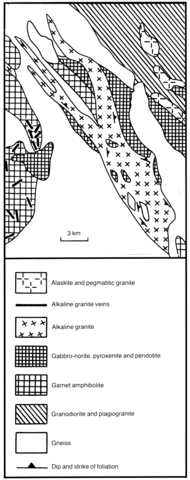stripes
Kanozerskii is controlled by a northwesterly-trending deep fault. It is an elongate body bifurcating to the northwest and has an area of 150 km2. Dykes, veins and small intrusions of alkaline granites occur to the east of the massif which consists essentially of peralkaline granite containing lepidomelane and ferrohastingsite. The principal minerals are quartz, plagioclase (albite-oligoclase), microcline, ferrohastingsite, lepidomelane and aegirine-augite. Accessory minerals are titanite, zircon, orthite, apatite, fluorite, pyrite and magnetite.
BATIEVA, I.D. 1976. The petrology of alkaline granitoids of the Kola peninsula. Nauka, Leningrad. 223 pp.
BATIEVA, I.D. 1985. Alkaline granites of the Kanozero-Kolvitsky lake. 1958. In. Alkaline granites of the Kola peninsula. Izdatelstvo Akademii Nauk SSSR, Moscow and Leningrad. 146-70.
PUSHKAREV, Yu.D. 1990. Megacycles in the evolution of the crust-mantle system. Leningrad. Nauka, Leningrad. 300 pp.

